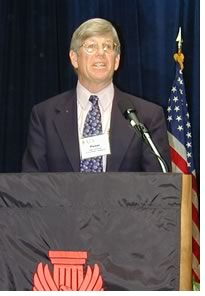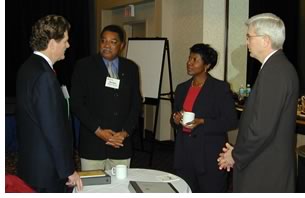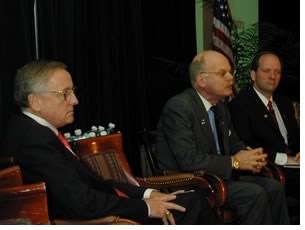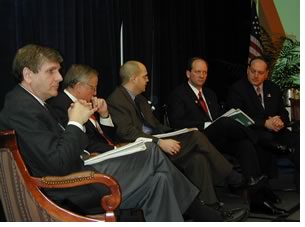

Politicians, Pundits Look to Grassroots Leaders
 Elected
representatives are always looking for reality checks with their constituents,
morning speakers emphasized and reemphasized to the Government Affairs
Day morning plenary gathering Thursday, March 6. To prepare AIA Grassroots
attendees to go to Capitol Hill that afternoon, politicians and analysts
conveyed the prevailing sense of foreboding in the face of war and budget
crunches and told the AIA representatives that some of the keys to a more
hopeful future are in architects’ hands. The focus of the visits
this year was to localize and make concrete the sometimes intangible benefits
of qualifications-based selection, reauthorization of TEA-21 to fund innovative
transportation efforts, and security through design.
Elected
representatives are always looking for reality checks with their constituents,
morning speakers emphasized and reemphasized to the Government Affairs
Day morning plenary gathering Thursday, March 6. To prepare AIA Grassroots
attendees to go to Capitol Hill that afternoon, politicians and analysts
conveyed the prevailing sense of foreboding in the face of war and budget
crunches and told the AIA representatives that some of the keys to a more
hopeful future are in architects’ hands. The focus of the visits
this year was to localize and make concrete the sometimes intangible benefits
of qualifications-based selection, reauthorization of TEA-21 to fund innovative
transportation efforts, and security through design.
Because access to the Hill is restrictive, members of Congress are now so focused on the buildup to possible Middle East hostilities, and so much of concern to the profession is taking place at the state level, this year’s AIA Grassroots Leadership and Legislative Conference morning session covered both national and state/local issues. Featured presenters and a discussion panel prepared attendees to work at home with state and local officials on issues of quality of living during times of severe fiscal pressure.
In touch with people
“We’re not gurus,” said PBS Washington
Week in Review Moderator and Managing Editor Gwen Ifill, who delivered
the opening presentation. So it’s good to get in touch with people
from across the country to see what the mood and interests are, she said.
Ifill gave her perspective on the difference between skepticism and cynicism
when evaluating politicians’ statements. She spent most of her time
at the dais taking questions, though, responding to and, she said, learning
from attendees’ concerns. Among her responses, she said she has
“every expectation” that a war in Iraq will come within two
weeks, that “front porch” issues of community concern are
difficult to get into the mix of daily stories in this turbulent times
(although still very important), and that design has become much more
important since September 11 as people who once thought of architecture
as “something that’s already there” now have some appreciation,
through the World Trade Center site redevelopment, of how it comes together.
 It
is heartening that the AIA is looking out beyond the bounds of Washington,
D.C., with this Grassroots program, which is rare for professional associations,
observed Peter Harkness, editor of Governing
magazine. With that encouragement—and guidance and inspiration from
AIA Government Affairs Managing Direct Rodney Clark and Federal Affairs
Senior Director Dan Wilson—AIA component presidents, presidents-elect,
and executives with appointments on the Hill were ready to grab box lunches
and head out to meet their representatives in Congress.
It
is heartening that the AIA is looking out beyond the bounds of Washington,
D.C., with this Grassroots program, which is rare for professional associations,
observed Peter Harkness, editor of Governing
magazine. With that encouragement—and guidance and inspiration from
AIA Government Affairs Managing Direct Rodney Clark and Federal Affairs
Senior Director Dan Wilson—AIA component presidents, presidents-elect,
and executives with appointments on the Hill were ready to grab box lunches
and head out to meet their representatives in Congress.
States in fiscal crunch look to taxes
The rest of the morning’s proceedings concentrated on state and
local issues, particularly the budget deficits, most of them severe, facing
46 of the 50 states this year. From 1996, when the federal and state governments
were celebrating surplus budgets with increased spending, decreased taxes,
or both, the bubble looked pretty solid. Considerable spending went to
k-12 schools and health-care benefits, said Harkness in his presentation,
“Harkening to the Homeland: Advocacy in an Era of Fiscal Crisis
Management for State and Local Governments.”
With the economy cool-down and consequent drop in both equity and value of investments, governments are suffering from budget crunches. Unlike the federal government, 49 states must balance their budgets every year. Exacerbating this, Harkness said, is the overwhelming number of state legislators (28 percent) who are new to state office. In Michigan, freshmen make up 70 percent of the state legislature. “So you’ve got amateur hour during this fiscal crisis,” he said. Tax-rate increases are inevitable, state bonding is hot now, states are selling tobacco payment over the next 25 year for pennies on the dollar to get money now, public services will be rethought or cut, state employees will be laid off, and it is likely that state constitutions will come under review. Everything is on the table, Harkness said, including taxes on professional services.
In the midst of this fiscal turmoil, federal, state, and local governments are splitting apart, Harkness said. One reason is unfunded mandates, another is preemption. When the Administration proclaims a mandate, such as No Child Left Behind, and leaves funding to states without funds, friction results. Likewise, federal laws can create conflict when they are in conflict with state laws and it isn’t clear whether federal law preempts state law or state law preempts nonexisting federal regulation. Examples Harkness offered were securities companies, prescription drugs, and environmental controls.
Panel plumbs depths, posits solutions
The concluding panel for the morning’s session on state and local
government concerns comprised three state legislators and three AIA-staff
commentators and added flesh to the framework already established. New
York State Senator Stephen M. Saland (R) spoke on one dichotomy between
campaign promises to cut taxes and increase services versus the reality
that “you can’t make both ends of a yardstick meet.”
This is particularly galling when the promises come from Capitol Hill
or the White House without funding to support it, such as the Bush-sponsored
tax cuts. Because many state income tax calculations are based on the
federal calculations, a federal cut translates to a state income tax cut
unless the state revises its constitution. Saland said that one challenge
for the New York Legislature is to avoid if at all possible sending unfunded
mandates on to the state’s county governments.
“I’ve never seen times as challenging as these,” Saland said, adding that the legislator with the longest tenure in the legislature hasn’t seen anything like this in his 45 years either. “We’ll get through this,” Saland said nonetheless.
 Tax
hikes?
Tax
hikes?
Cutting taxes is so much of a knee-jerk campaign promise that Ohio’s
freshman legislators are finding themselves in a situation unknown to
many of them in their entire adult lives: swallowing the bitter pill of
tax hikes. “All the low-hanging fruit has been picked,” Ohio
State Representative Chistopher Widener, FAIA, told the Grassroots audience.
Moreover, he said, “nitty-gritty politics trumps common sense every
time. Everyone wants to go to heaven, but nobody wants to die.”
All the rainy-day funds are gone, tobacco money for 25 years is gone,
tobacco and alcohol taxes have already been raised. This is a situation
of crisis management, something architects are trained to provide, Widener
said.
In particular, architects need to be wary of the lure of professional-service taxes, he said. Ohio stands to gain $454 million from taxing architectural services. Every AIA state component should know what the number is on the table in their own state legislatures. Organize and work on it, Widener advised. Start a relationship with your key legislators, and reinforce it with a donation, he said, adding that architects are not buying influence with such a jesture, but are showing they are serious about their convictions.
The boom years of the late 1990s were so good that North Carolina cut its taxes, pointed out North Carolina State Representative Ed McMahan (R). Last year, the state legislature was forced to increase taxes. “We collected less revenue,” McMahan said, because of the downturn in technology and banking industries key to North Carolina’s tax base. It’s hard to tax your way out of a recession. “We’ve got to get back to growing our economy,” he said in support of the Bush economic stimulus package now under consideration. North Carolina is being very aggressive in bringing corporations into the state, McMahan said.
 His
advice to architects is to watch the liability issues, especially in case
of fire safety (following the Rhode Island concert fire). Furthermore,
there are so many freshman state legislators, architects need to spend
time educating them on the issues
His
advice to architects is to watch the liability issues, especially in case
of fire safety (following the Rhode Island concert fire). Furthermore,
there are so many freshman state legislators, architects need to spend
time educating them on the issues
A shallow recession
AIA Chief Economist Kermit Baker, PhD, Hon. AIA, reported that architect’s
business conditions are directly dependent on their clients. Half of architects’
work comes from private businesses, a third comes from governments, and
a sixth comes from nonprofit institutions. All these sectors are hurting
now, and there is nowhere to turn for relief from seven straight months
of sagging billings. On a brighter tone, the declines have been shallow
relative to the 1990 recession, and inquiries are beginning to pick up,
so we may be seeing some relief over the next seven to nine months, Baker
said. “The elephant in the corner is Iraq,” he warned. “Once
that’s resolved, we can assess how our recovery looks. I think we’ll
see some recovery.”
Copyright 2003 The American Institute of Architects.
All rights reserved. Home Page ![]()
![]()
 |
||
|
|
||